We visited Kana's London Fields studio to meet founder Ana Kerin and find out how her functional, handbuilt pieces take a sculptural approach that throws out the rulebook on traditional ceramic practices...
 Finished and glazed pots on Ana's studio's shelves.
Finished and glazed pots on Ana's studio's shelves.
Finished and glazed pots on Ana's studio's shelves.
Finished and glazed pots on Ana's studio's shelves.

GOODHOOD: Thanks for chatting with us, Ana. Firstly, what is your background? What brought you to make ceramics?
ANA KERIN: So my background is actually in fine art. I'm a sculptor, and I was really lucky that I studied at this really old-fashioned fine art academy in Slovenia, where I'm from. It was very academic with a lot of theory, art history, everything. As a sculptor, you have to do painting, graphics, and a lot of training in different materials. You have to work with stone, metal, wood, clay, plaster... And I always went back to clay. It always ended up being, the majority of the time, my material of choice.
GH: How come there was such an affinity for clay?
AK: I think it's just something about its tactile nature, and how it really holds your fingerprints. You can respond to it so fast, but at the same time, you really have to work on it. I really enjoy the transition when you do a certain piece, and it's maybe an installation—it's in an environment when you're not allowed to touch it, but it might also be a ceramic piece—but at the end, you take it home and you just use it. It has to live life with you and it becomes a bowl for your coins, a doorstop, anything. Suddenly these pieces start living life with you and they're not those fine art objects anymore. So I like to push those boundaries.
The other side is that I really love food. I love working with the rituals around food and how it tells stories. It's such an important medium for tracing a personal story, a family story, the story of a nation... it's beautiful and it's an art form in itself. It's a way of telling stories, and the ceramics are part of that.
I really love how we all have a 'special mug' or a 'favourite cup'—we always like a particular one. I love that kind of habit and there's something about the ritual around it. It makes me happiest when I have people coming back to me saying "we only use your ceramics". I think, as well, that this is my way of working towards 'less is more' and against the consumption world, where you invest in a few beautiful pieces that you really want to use instead of having lots of stuff you don't like.
"SUDDENLY THESE PIECES START LIVING LIFE WITH YOU AND THEY'RE NOT THOSE FINE ART OBJECTS ANYMORE"
GH: Do you think there's more of a push nowadays towards that, the ideas of championing sustainability and quality?
AK: For sure. And I think that's why people like my work. That's part of the reason I wanted to do it, art meets function, to add in that value. But it's hard to talk about sustainability when you produce ceramics because, of course, I'm using a lot of electricity and water. But, at the same time, I'm hoping that people are going to want to hold onto these objects instead of treating it as a seasonal item that will fall out of fashion.
My sister and I had this saying when we were little—we moved with our mother a lot—that you're only allowed to buy new things if you would be proud to inherit it. Something that people would actually want to have, something that represents you and who you are.
GH: What is a typical day in your studio like? What's your routine?
AK: There isn't really one! Unfortunately, but also, fortunately, I can't have a routine. It's tricky because it's the nature of the clay; your schedule is centred around the kiln. You're working around something that dictates your time, but I try to have days where I have mostly meetings and days where I have none and just work. And I started recently having 'Art Wednesdays', a day when I am doing work on my own new stuff, or collaborations with different artists. When you're working constantly on orders or collections for clients, there's no space in which you can play and accommodate the chance to come up with new ideas.
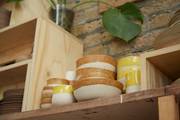
GH: There must be a really serene aspect to working with clay. Do you find you just zone in and hours pass?
AK Yeah, you start and suddenly it's 4 pm and you're like 'what happened?!' You don't get through even half of what you were supposed to do. The material is so unpredictable so sometimes it's not as relaxing as that!
GH: It’s interesting how dependent on the clay and external conditions ceramicists are. Do you find part of the appeal is that the material is so dynamic and responsive?
AK: It's a stressful part! That's the tricky thing but, on the other hand, I always say in my classes how fascinating I find it that the craft is working with the most primitive things you could – it's soil, water, air, and fire. It's the four elements. So I constantly have to respond to humidity, temperature, the clay itself... It's interesting because it's so different from how our society is structured right now.
"SUDDENLY THESE PIECES START LIVING LIFE WITH YOU AND THEY'RE NOT THOSE FINE ART OBJECTS ANYMORE"
GH: How did you end up in this particular studio?
AK: So, the guy who owns it, he invests in properties with stories, properties that are period buildings and those which have a historical element. He restored this building perfectly as it was in really bad condition. It was previously an artist's studios and a wood workshop. I had been looking for a new space for a long time, but it's very difficult because there are so many factors you have to take into account, such as air flow, industrial electricity supply and more. I had been looking for a year and a half, and I was in Guatemala boarding a plane and my friend texted me photos saying they'd found a space!
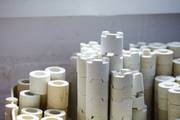
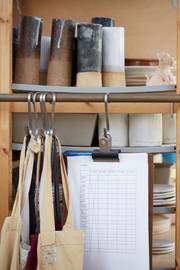

A selection of books and ceramics in Ana's studio.
GH: You do workshops and events here too, don't you?
AK: I do a few different things. I teach my own classes, either one-off sessions where I guide people through working with clay who come out with items that I glaze and finish off for them. I also do a three-week 'explorer' session which is more in-depth and focuses on understanding the process. I'm also teaching weekend retreats where you come for a whole day and have breakfast in the morning, lunch in-between, and because you have so much more time you really ease into it, which is really nice. And I also do collaborative sessions with friends where you make a bowl and then there is a cooking session on the end with Alex from 26 Grains for example or a workshop about brewing coffee. I also run private workshops with people for birthdays, team-building days and more!
GH: How do you feel London's design and making community is at the moment? There's a lot of small, independent creative like you operating out of studios across the city...
AK: I think London, for me, has always been really interesting because of that. I think that it has a very healthy balance and I think it has to do with the fact there's such a huge flow of people constantly coming in and out. In general, it's good to see how much people are seriously considering everything that is sustainable and taking fewer compromises. London is really good with that, even if it has some sustainability issues of its own since it's such a big city.
I remember I felt like that when I went to Amsterdam or Denmark, I thought about how they seemed to be so ahead of us with being really environmentally friendly about everything. But I think now with the design scene here, it's a really good trend! It's not like you're being weird by buying organic—now everyone is thinking that way. All of those small steps count.
GH: Finally, what can we expect next from Kana?
AK: I've been working for the past year and a half to two years on the new collection. It’s called Nude and as a sculptor, I wanted to go back to material and form which is primarily where my interests lie. So the whole collection is based on four different colours of clay. I redesigned the whole dinnerware collection, and some are a lot more sculptural. I'm really excited about that and I'm working on a few interesting collaborations at the moment, but there's a lot of experimental work between ceramics and furniture I'm working on as well!
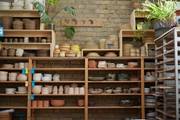
A selection of ceramics finished and awaiting glazing on the shelves in the Kana studio.
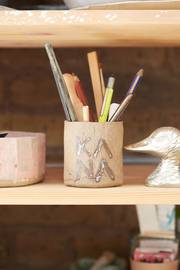

A custom-made Kana pen pot & plates awaiting 'F*ck' glazing.










































































































